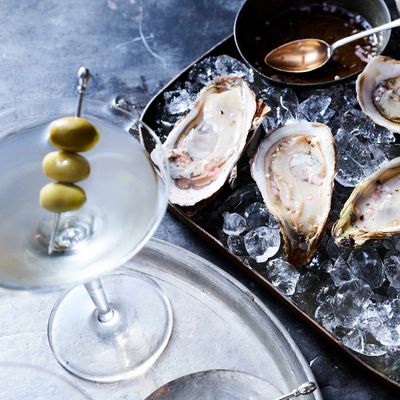
Sitting in the lobby of Nine Orchard, the fancy hotel on the corner of Canal and Orchard Streets and around the corner from the newly gentrified area now dubbed Dimes Square, I was surrounded by beauty. Beautiful tall ceilings, beautiful embroidered booths that curved and stretched to caress their patrons, beautiful mirrored tables with beautiful, impossibly tiny lamps nestled on them, and, most importantly, beautiful people in beautiful clothes slurping beautiful … sea boogers.
Platters of oysters perched on beds of crushed ice hurried in and out of swinging doors toward tables already adorned with martinis. Ah, yes. I’d seen this, increasingly often, on Instagram — it seems the hotties of New York have decided on a briny snack du jour: oysters washed down with a dirty martini. With the lack of a substantial meal combined with a dressed-up iteration of straight alcohol, these people would soon be drunk in a manner their wallets would thank them for and their heads would hate them for the next morning. The happiest hours should have more than just bivalves!
On any given day, between the hours of 4 p.m. and 8 p.m., my coolest friends, far off acquaintances, and hotties I’ve never met but would like to know inundate their respective Instagram Stories with this salty duo. Often, there is no one in the photo, just an aerial view of a platter of oysters and newly shaken or stirred martinis. And yet, the images vary in the vibes they emanate. The coastal grandmothers trapped in the bodies of 20-something-year-olds are often more simplistic in their imagery — nonuniform, freshly shucked oysters atop a few ice cubes on a tea towel and one lemon wedge, probably served at their beach cottage. The New York City–based baddies often photograph their oysters and martinis in dim lighting, likely at the table of some ambient spot they had to reserve at least a week ago.
The latter group often seems to follow up with another photo, at another bar down the street or with a photo of another round of drinks. And while I delight in the presumed fun these beautiful people are having, I must publicly denounce the adoption of these tiny oysters as a meal of their own, especially when paired with several rounds of alcoholic beverages!
Growing up in Kansas, oysters never quite found their way onto my plate or into my palate. The closest I got was my father lovingly cracking clams open for me at a Golden Corral, which I somehow digested without a trip to the emergency room. But upon my arrival on the East Coast, it was apparent how intertwined these slimy creatures were to the New York City scene. I lived a street over from the now-closed Zadie’s Oyster Room, where they were sold at $1.50 apiece, and remember my bewilderment when I stumbled upon this restaurant that was seemingly kept alive by serving solely shellfish. In hindsight, it makes sense. For some New Yorkers, oysters are a way of life.
Evelina Edens, a 25-year-old marketing associate at Seed + Mill and owner of Wear Your Snacks, for example, considers herself a “total salthound.” Edens has aligned herself so deeply with the mollusk that she owns oyster-print pajamas, has an oyster tattoo, and named her dog Mignonette, after the sauce made of minced shallots and vinegar often served with oysters, a name she also has tattooed on her arm. She’s also planning an oyster tour around the Northeast for her birthday weekend at the end of the summer.
“I think it’s kind of a chic thing to like,” Edens, whose favorite way to eat oysters is with a dirty gin martini, said. “And I think the more they pop up on menus, the less freaked people are about the raw-bivalve thing.”
The martini has reigned supreme all summer long for understandable reasons — it helps wash down, say, the loss of our bodily autonomy — but what is it about oysters that has us inhaling this adult finger food in tandem with our cocktails like Don Draper and Roger Sterling at a midday lunch?
Perhaps the average New Yorker is thirsty to replace the sodium they lose via sweat from simply leaving their apartments in 90-degree heat? Maybe we’re all looking to microdose opulence with a far-less-cringe cousin of the caviar bump? Or might it have to do with the Lipstick Effect, that as we head into an inevitable recession (unless we’re already there), people grasp for those everyday, inexpensive things we deem little luxuries to make our collective conscience feel less strapped for cash?
“Oysters are disarming,” Henry Furman, a 30-year-old entrepreneur in Los Angeles who spent several years working at Peeko Oysters in New York, said. “They bring everyone down to earth. Most people look stupid, messy, scared, or all of the above when they enjoy an oyster. I don’t know another food that has that effect.”
Consider them, then, the Pete Davidsons of food: gorgeous in their own way, heavily consumed by beautiful people, and, yet, equalizing and totally not intimidating.
Furman swears the best oysters in New York are harvested on Long Island (this is where Pete and oysters differ — same state, different islands). “People in the city don’t realize it, but Long Island’s aquaculture tradition is legendary,” he said. “The unique tidal patterns and salinity levels throughout the year produce a brine that you can’t replicate elsewhere.”
But down the shore, off the coast of the city, oysters have been consumed for hundreds of years. First, by the Lenape people, with reports of oysters measuring ten inches long (perhaps a few of these big boys could constitute a meal), and ultimately by Dutch settlers, who upon their arrival took note of the abundance of mollusks in the area and dubbed Ellis Island and Liberty Island “Little Oyster Island” and “Great Oyster Island,” respectively. They even went so far as to pave Pearl Street with oysters. Mark Kurlansky describes the relationship between New Yorkers and oysters perfectly in his book, The Big Oyster: “The history of the New York oyster is a history of New York itself — its wealth, its strength, its excitement, its greed, its thoughtfulness, its destructiveness, its blindness, and — as any New Yorker will tell you — its filth.”
There you have it. No matter how hard we may try to suggest otherwise, New Yorkers love a certain type of filth. Why else would we love these hard-shelled, glorified slugs and toss the word “dirty” in front of our current drink of choice, the martini (which also has deep New York City roots, fabled to have been invented at the Knickerbocker Hotel in Times Square). In essence, being a New Yorker, an oyster-eater, and a martini-drinker go hand in hand in hand, AND YET, despite our culture being so profoundly tied to brine-based delicacies, a meal they do not make!
So why, then, are hot spots marketing this non-meal heavily to their hot patrons? Deux Chats, a bar in Williamsburg, seems to hope to beckon these dehydrated hotties with salty salvation. Its to-the-point and on-trend Instagram bio reads, “A neighborhood bar serving ‘perfect’ martinis and seafood towers.” The Mermaid Inn, a seafood restaurant with locations across Manhattan, Instagrammed a photo with the caption “oysters + 🍸 = 🕶 #SummerVibes.” I couldn’t have said it better myself, although I’m curious to know why the perfectly good oyster emoji was so unnecessarily neglected in that equation. In the West Village, Jeffrey’s Grocery, a spot overflowing with well-rested, wealthy-looking people, serves a gargantuan seafood tower, with 16 oysters in part, for $145. On its Instagram, the caption “Seafood Tower Friday’s, anyone? ✨🍸 🐡” seems to be attempting to pull a trend out of thin air.
Pippa Allen, a 26-year-old culinary publicist who lives in the Lower East Side, admits to being “an oyster fiend,” and soon she’ll have proof: “I’m getting an oyster tattoo in a few weeks.” But even she can admit what every hot girl with a food-industry job knows is true: This value-meal combo is barely a snack. Many are throwing these babies back with your conical glasses of straight liquor expecting more sobering results, but “it’s not an actual meal,” Allen says. “It’s a precursor to an evening getting fucked up in a slip dress.”
So maybe that’s it: efficiency. It’s not the recession, or the aesthetic, or the chic griminess. The lack of a substantial meal or any true nutritional significance (six oysters contain about 50 calories) combined with a dirty martini, which is a glorified, salty drink on the rocks, leads to near-immediate intoxication on a dime.
These are the same salty aphrodisiacs Sylvia Plath presumably loved and ate for breakfast, washing them down with “wine and wine.” I highly doubt your doctor would be happy to hear you decided on a similar, Plath-adjacent combo for dinner. But then again, if any of you see me out ingesting this combo, look the other way and know that I ordered a food-pyramid-friendly meal to follow.





